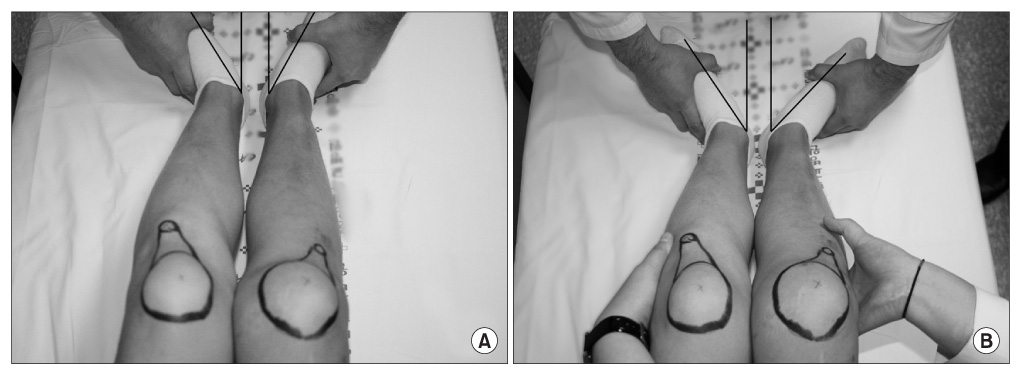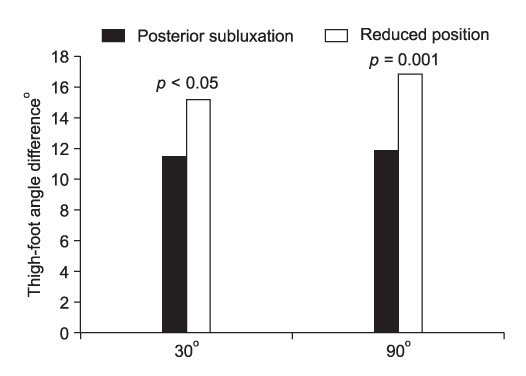Clin Orthop Surg.
2009 Jun;1(2):68-73. 10.4055/cios.2009.1.2.68.
The Influence of Tibial Positioning on the Diagnostic Accuracy of Combined Posterior Cruciate Ligament and Posterolateral Rotatory Instability of the Knee
- Affiliations
-
- 1Department of Orthopedic Surgery, Medial Center of Chung-Ang University, Knee Center, Seoul, Korea. changcape@naver.com
- 2Department of Orthopedic Surgery, Korea University, Ansan Hospital, Ansan, Korea.
- KMID: 1122635
- DOI: http://doi.org/10.4055/cios.2009.1.2.68
Abstract
-
BACKGROUND: To determine if tibial positioning affects the external rotation of the tibia in a dial test for posterolateral rotatory instability combined with posterior cruciate ligament (PCL) injuries.
METHODS
Between April 2007 and October 2007, 16 patients with a PCL tear and posterolateral rotatory instability were diagnosed using a dial test. The thigh-foot angle was measured at both 30degrees and 90degrees of knee flexion with an external rotation stress applied to the tibia in 2 different positions (reduction and posterior subluxation). The measurements were performed twice by 2 orthopedic surgeons.
RESULTS
In posterior subluxation, the mean side-to-side difference in the thigh-foot angle was 11.56 +/- 3.01degrees at 30degrees of knee flexion and 11.88 +/- 4.03degrees at 90degrees of knee flexion. In the sequential dial test performed with the tibia reduced, the mean side-to-side difference was 15.94 +/- 4.17degrees (p < 0.05) at 30degrees of knee flexion and 16.88 +/- 4.42degrees (p = 0.001) at 90degrees of knee flexion. The mean tibial external rotation was 5.31 +/- 2.86degrees and 6.87 +/- 3.59degrees higher in the reduced position than in the posterior subluxation at both 30degrees and 90degrees of knee flexion.
CONCLUSIONS
In the dial test, reducing the tibia with an anterior force increases the ability of an examiner to detect posterolateral rotary instability of the knee combined with PCL injuries.
MeSH Terms
Figure
Cited by 1 articles
-
Recent Evolution of Cruciate Ligament Surgery of the Knee
Young-Bok Jung
Clin Orthop Surg. 2012;4(2):103-106. doi: 10.4055/cios.2012.4.2.103.
Reference
-
1. Albright JP, Brown AW. Management of chronic posterolateral rotatory instability of the knee: surgical technique for the posterolateral corner sling procedure. Instr Course Lect. 1998. 47:369–378.2. LaPrade RF, Terry GC. Injuries to the posterolateral aspect of the knee: association of anatomic injury patterns with clinical instability. Am J Sports Med. 1997. 25(4):433–438.3. Noyes FR, Barber-Westin SD. Surgical reconstruction of severe chronic posterolateral complex injuries of the knee using allograft tissues. Am J Sports Med. 1995. 23(1):2–12.
Article4. Noyes FR, Barber-Westin SD. Surgical restoration to treat chronic deficiency of the posterolateral complex and cruciate ligaments of the knee joint. Am J Sports Med. 1996. 24(4):415–426.
Article5. Baker CL Jr, Norwood LA, Hughston JC. Acute posterolateral rotatory instability of the knee. J Bone Joint Surg Am. 1983. 65(5):614–618.
Article6. Baker CL Jr, Norwood LA, Hughston JC. Acute combined posterior cruciate and posterolateral instability of the knee. Am J Sports Med. 1984. 12(3):204–208.
Article7. Veltri DM, Warren RF. Operative treatment of posterolateral instability of the knee. Clin Sports Med. 1994. 13(3):615–627.
Article8. O'Brien SJ, Warren RF, Pavlov H, Panariello R, Wickiewicz TL. Reconstruction of the chronically insufficient anterior cruciate ligament with the central third of the patellar ligament. J Bone Joint Surg Am. 1991. 73(2):278–286.9. Larsen MW, Toth A. Examination of posterolateral corner injuries. J Knee Surg. 2005. 18(2):146–150.
Article10. Jacobsen K. Gonylaxometry. Stress radiographic measurement of passive stability in the knee joints of normal subjects and patients with ligament injuries: accuracy and range of application. Acta Orthop Scand Suppl. 1981. 194:1–263.11. Strauss EJ, Ishak C, Inzerillo C, et al. Effect of tibial positioning on the diagnosis of posterolateral rotatory instability in the posterior cruciate ligament-deficient knee. Br J Sports Med. 2007. 41(8):481–485.
Article12. Bleday RM, Fanelli GC, Giannotti BF, Edson CJ, Barrett TA. Instrumented measurement of the posterolateral corner. Arthroscopy. 1998. 14(5):489–494.
Article13. Gollehon DL, Torzilli PA, Warren RF. The role of the posterolateral and cruciate ligaments in the stability of the human knee: a biomechanical study. J Bone Joint Surg Am. 1987. 69(2):233–242.
Article14. LaPrade RF, Wentorf F. Diagnosis and treatment of posterolateral knee injuries. Clin Orthop Relat Res. 2002. (402):110–121.
Article15. LaPrade RF, Bollom TS, Wentorf FA, Wills NJ, Meister K. Mechanical properties of the posterolateral structures of the knee. Am J Sports Med. 2005. 33(9):1386–1391.
Article16. Grood ES, Stowers SF, Noyes FR. Limits of movement in the human knee: effect of sectioning the posterior cruciate ligament and posterolateral structures. J Bone Joint Surg Am. 1988. 70(1):88–97.
Article17. LaPrade RF, Muench C, Wentorf F, Lewis JL. The effect of injury to the posterolateral structures of the knee on force in a posterior cruciate ligament graft: a biomechanical study. Am J Sports Med. 2002. 30(2):233–238.
Article18. Markolf KL, Wascher DC, Finerman GA. Direct in vitro measurement of forces in the cruciate ligaments. Part II: The effect of section of the posterolateral structures. J Bone Joint Surg Am. 1993. 75(3):387–394.
Article19. Veltri DM, Warren RF. Posterolateral instability of the knee. Instr Course Lect. 1995. 44:441–453.
Article20. Warren LA, Marshall JL, Girgis F. The prime static stabilizer of the medical side of the knee. J Bone Joint Surg Am. 1974. 56(4):665–674.21. Laprade RF, Wentorf FA, Olson EJ, Carlson CS. An in vivo injury model of posterolateral knee instability. Am J Sports Med. 2006. 34(8):1313–1321.
Article22. Vogrin TM, Hoher J, Aroen A, Woo SL, Harner CD. Effects of sectioning the posterolateral structures on knee kinematics and in situ forces in the posterior cruciate ligament. Knee Surg Sports Traumatol Arthrosc. 2000. 8(2):93–98.
Article23. Pritsch T, Blumberg N, Haim A, Dekel S, Arbel R. The importance of the valgus stress test in the diagnosis of posterolateral instability of the knee. Injury. 2006. 37(10):1011–1014.
Article24. Kennedy JC, Fowler PJ. Medial and anterior instability of the knee: an anatomical and clinical study using stress machines. J Bone Joint Surg Am. 1971. 53(7):1257–1270.25. Fanelli GC, Larson RV. Practical management of posterolateral instability of the knee. Arthroscopy. 2002. 18(2):Suppl 1. 1–8.
Article26. Noyes FR, Stowers SF, Grood ES, Cummings J, VanGinkel LA. Posterior subluxations of the medial and lateral tibiofemoral compartments: an in vitro ligament sectioning study in cadaveric knees. Am J Sports Med. 1993. 21(3):407–414.
Article
- Full Text Links
- Actions
-
Cited
- CITED
-
- Close
- Share
- Similar articles
-
- Pitalls in Interpretation of Physical Tests of Knee Ligament Injury
- Combined Reconstruction of Posterior Cruciate Ligament and Posterolateral Rotatory Instability with Fresh-frozen Achilles Tendon Allograft
- Operative Methods of Chronic Anteromedial Rotatory Instability of Knee: Advancement and Bony Reinsertion Operation of Tibial Collateral Ligament
- Analysis of 33 Knees with Lateral Instability
- Dislocation of Tibial Insert after Fixed Bearing TKA using Minimal Invasive Surgery: A Case Report



